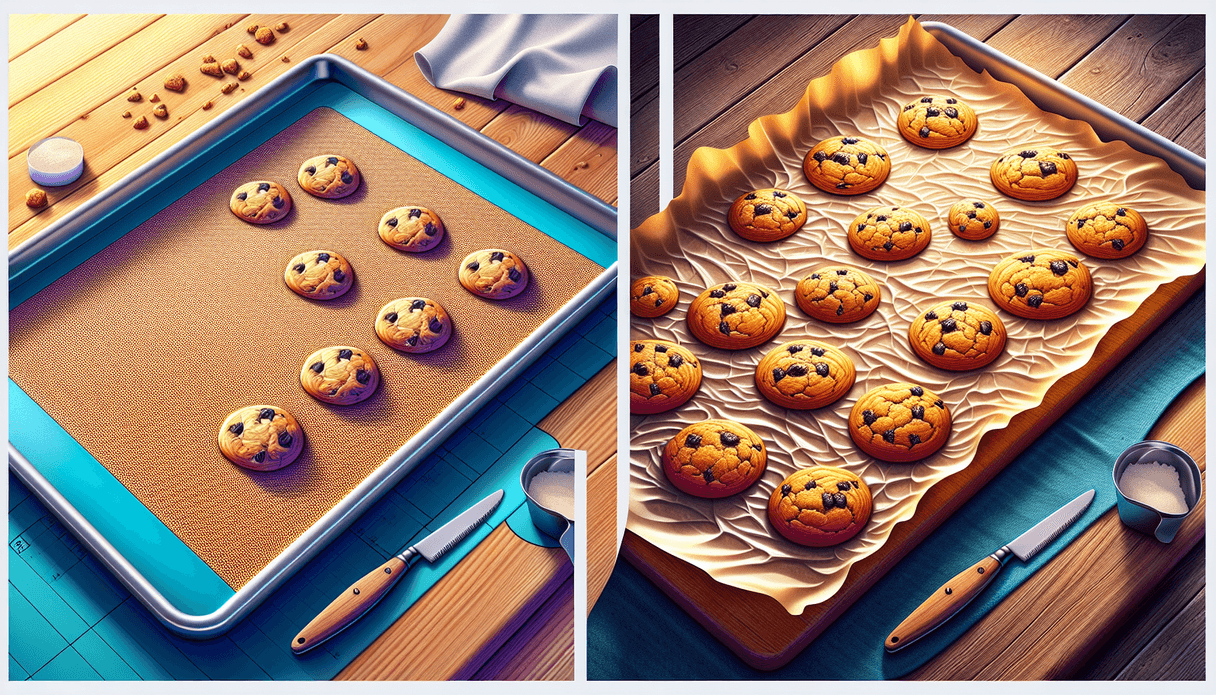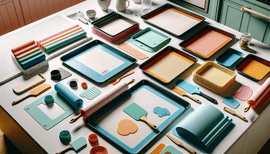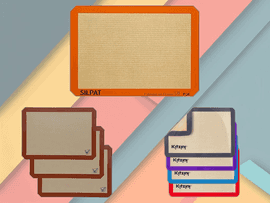When it comes to baking, achieving the perfect result often depends on the tools you use. Among the most debated tools in the baking world are silicone baking mats and parchment paper. Both have their unique advantages and disadvantages, and choosing the right one can significantly impact your baking experience. In this comprehensive comparison, we'll explore the features, benefits, and drawbacks of silicone baking mats and parchment paper to help you decide which is better for your baking needs.
What Are Silicone Baking Mats?
Silicone baking mats are non-stick, reusable mats made from food-grade silicone. They are designed to replace parchment paper and other disposable baking liners. These mats are versatile and can be used for baking cookies, roasting vegetables, and even rolling out dough.
Key Features and Benefits of Silicone Baking Mats
-
Non-Stick Surface: Silicone baking mats offer exceptional non-stick performance, eliminating the need for greasing or oiling. This feature ensures that your baked goods release effortlessly from the mat.
-
Durability: These mats are built to last and can withstand thousands of uses. For example, the MIU France Silicone Baking Mat is reusable up to 3000 times, making it a cost-effective option in the long run.
-
Wide Temperature Range: Silicone baking mats can handle a wide range of temperatures, typically up to 480°F. This makes them suitable for various baking and roasting tasks.
-
Easy Cleanup: Cleaning silicone baking mats is a breeze. Most mats are dishwasher safe, and even those that require hand washing can be cleaned effortlessly with soap and water.
-
Multiple Sizes Available: Silicone baking mats come in various sizes to fit different baking sheets. For instance, the Silpat Premium Non-Stick Silicone Baking Mat offers multiple size options, ensuring a perfect fit for your baking needs.
Popular Silicone Baking Mats
-
Silpat Premium Non-Stick Silicone Baking Mat: Known for its exceptional non-stick performance and durability, this mat is a favorite among professional bakers. It eliminates the need for grease and offers effortless cleanup. Buy on Amazon.
-
AmazonBasics Silicone Baking Mat: This budget-friendly option provides excellent non-stick performance and durability. It is hand wash only but offers great value for its price. Buy on Amazon.
-
Artisan Silicone Baking Mat: Strong and flexible, this mat is dishwasher safe and offers effortless food release. It is available in medium size only. Buy on Amazon.
-
Kitzini Silicone Baking Mat: Reinforced with fiberglass mesh, this mat offers exceptional non-stick performance and durability. It comes in a set of four half-sheet mats. Buy on Amazon.
-
MIU France Silicone Baking Mat: Reusable up to 3000 times, this mat is dishwasher safe and comes in three sizes. Buy on Amazon.
-
Velesco Silicone Baking Mat: Tear-resistant and long-lasting, this mat is dishwasher safe and comes in a set of three mats. Buy on Amazon.
-
GRIDMANN Pro Silicone Baking Mat: Handles metal utensils and offers excellent non-stick performance. It is dishwasher safe and available in standard half-sheet size. Buy on Amazon.
What Is Parchment Paper?
Parchment paper is a disposable, non-stick paper used in baking and cooking. It is coated with silicone or quilon to provide a non-stick surface. Parchment paper is commonly used for lining baking sheets, wrapping food, and creating piping bags.
Key Features and Benefits of Parchment Paper
-
Convenience: Parchment paper is disposable, making cleanup quick and easy. After use, you can simply throw it away, eliminating the need for washing.
-
Versatility: Parchment paper can be used for various tasks, including baking, roasting, steaming, and wrapping food. It is also handy for rolling out dough and making parchment paper pouches for cooking.
-
Non-Stick Surface: Like silicone baking mats, parchment paper offers a non-stick surface that prevents food from sticking. This ensures that your baked goods release easily from the paper.
-
Heat Resistance: Parchment paper can withstand high temperatures, typically up to 450°F. This makes it suitable for most baking and roasting tasks.
-
Customizable Size: Parchment paper can be cut to fit any baking sheet or pan, providing flexibility in its use.
Drawbacks of Parchment Paper
-
Single-Use: Unlike silicone baking mats, parchment paper is disposable and cannot be reused. This can lead to increased waste and higher long-term costs.
-
Limited Durability: Parchment paper can tear or burn if exposed to high temperatures for extended periods. It is not as durable as silicone baking mats.
-
Environmental Impact: The disposable nature of parchment paper contributes to waste and environmental impact. Silicone baking mats, on the other hand, are reusable and more eco-friendly.
Silicone Baking Mats vs. Parchment Paper: A Detailed Comparison
Non-Stick Performance
Both silicone baking mats and parchment paper offer excellent non-stick performance. However, silicone baking mats tend to provide a more consistent and reliable non-stick surface, especially for sticky or delicate items like macarons and meringues.
Winner: Silicone Baking Mats
Durability
Silicone baking mats are designed for long-term use and can withstand thousands of baking cycles. Parchment paper, being disposable, lacks durability and is intended for single-use only.
Winner: Silicone Baking Mats
Heat Resistance
Both silicone baking mats and parchment paper can handle high temperatures, typically up to 480°F for silicone mats and 450°F for parchment paper. However, silicone mats have a slight edge in terms of maximum temperature tolerance.
Winner: Silicone Baking Mats
Ease of Cleaning
Silicone baking mats are easy to clean and are often dishwasher safe. Parchment paper, being disposable, does not require cleaning but contributes to waste.
Winner: Silicone Baking Mats
Cost-Effectiveness
While silicone baking mats have a higher upfront cost, their reusability makes them more cost-effective in the long run. Parchment paper, though cheaper initially, requires continuous repurchasing.
Winner: Silicone Baking Mats
Environmental Impact
Silicone baking mats are reusable and eco-friendly, reducing waste compared to disposable parchment paper. Parchment paper contributes to environmental waste due to its single-use nature.
Winner: Silicone Baking Mats
Versatility
Parchment paper is more versatile in terms of its applications. It can be used for baking, roasting, steaming, and wrapping food. Silicone baking mats are primarily used for baking and roasting.
Winner: Parchment Paper
Conclusion: Which Is Better?
Both silicone baking mats and parchment paper have their unique advantages and are valuable tools in any kitchen. However, if we consider factors like non-stick performance, durability, ease of cleaning, cost-effectiveness, and environmental impact, silicone baking mats emerge as the superior choice.
For those who prioritize convenience and versatility, parchment paper remains a reliable option. However, for avid bakers looking for a long-term, eco-friendly solution, investing in a high-quality silicone baking mat, such as the Silpat Premium Non-Stick Silicone Baking Mat, is a wise decision.
Ultimately, the choice between silicone baking mats and parchment paper depends on your specific needs and preferences. Consider the factors discussed in this comparison to make an informed decision that enhances your baking experience.





